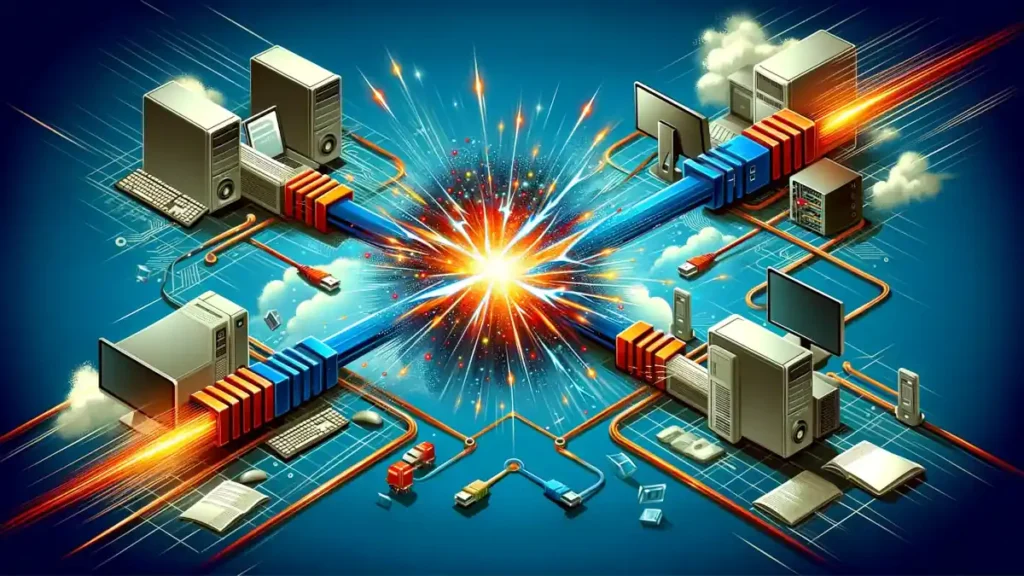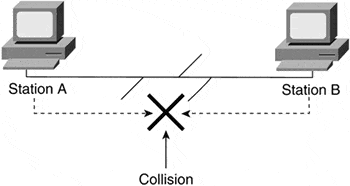In computer networking, a collision is a fundamental concept that occurs when two or more devices attempt to transmit data over the network simultaneously on the same channel or medium. This phenomenon is particularly prevalent in networks using a shared medium, such as Ethernet in its classic form. Collisions can lead to network inefficiencies, data loss, and a decrease in overall network performance.
This article aims to provide an in-depth exploration of the concept of collisions in networking, detailing their causes, implications, and the mechanisms in place to detect, avoid, and resolve them. Understanding collisions is crucial for network professionals and students alike, as it forms the basis for designing more efficient and reliable network systems.
Table of Contents:
- What is a Collision in Networking?
- Causes of Collisions in Computer Networks
- Effects of Collisions on Network Performance
- Collision Detection and Avoidance Techniques
- Evolution of Networking Technologies to Mitigate Collisions
- Case Studies and Real-World Applications
- Conclusion: The Importance of Understanding Collisions
- References

1. What is Collision in networking?
In computer networking, a collision is an event that occurs when two or more devices attempt to send a packet over a network segment at the same time. Collisions are specific to networks that use a shared communication medium, such as traditional Ethernet with a bus topology. When a collision happens, the data packets being transmitted interfere with each other, leading to corrupted or lost data. To ensure successful communication, network protocols employ various methods to detect and manage collisions, preventing data loss and ensuring efficient use of the network.
Collisions were a common issue in early network designs, particularly in networks using Carrier Sense Multiple Access with Collision Detection (CSMA/CD) technology. Understanding how collisions occur and how they are managed is key to comprehending network performance and efficiency, especially in the context of network design and troubleshooting.

How Collision Works
When a station begins transmitting a signal and detects a collision, the station stops transmitting and issues a jam signal to tell the other station that a collision has occurred. Both stations then stop transmitting and wait a random interval of time before retransmitting their signals. The amount of time the stations wait before retransmitting increases with the number of collisions occurring on the network.
A collision can only occur at the physical layer in the OSI model. When multiple devices share a common media at the physical layer, which happens when you have multiple devices connected with a hub, there is a possibility that you will have a collision. The network area where a collision may occur is called a collision domain.
2. Causes of Collisions in Computer Networks
2.1 Shared Communication Mediums
Collisions are most likely to occur in networks where multiple devices share the same communication medium. In such setups, when two or more devices attempt to transmit data simultaneously, their signals can overlap and corrupt the transmitted information. Early Ethernet networks, which often operated on a shared bus topology, are classic examples where collisions were a common occurrence. The use of hubs, which broadcast incoming data to all connected devices, also contributed to the likelihood of collisions in a shared network environment.
2.2 Network Topology and Design
The design and topology of a network play a significant role in collision occurrences. Network topologies like bus and ring are more prone to collisions due to their shared pathway for data transmission. The bus topology, in particular, where each computer is connected to a single cable, can lead to high collision rates in a busy network. In contrast, a star topology, often seen in modern networks with switches, significantly reduces the risk of collisions. The way a network is designed, including the choice of devices like hubs or switches, directly impacts the frequency and management of collisions.
3. Effects of Collisions on Network Performance
3.1 Data Loss and Retransmissions
Collisions in a network often result in data loss, as the overlapping data packets become corrupted and unreadable. This necessitates the retransmission of data, adding overhead and latency to network communication. In high-collision environments, such as those with excessive network traffic or poorly designed network topologies, the need for frequent retransmissions can significantly hamper network performance. This constant cycle of data loss and retransmission not only slows down data transfer rates but also consumes valuable network bandwidth, leading to inefficiencies.
3.2 Network Throughput and Efficiency
Network throughput, the rate at which data is successfully transmitted, is directly affected by collisions. High rates of collisions decrease throughput as more bandwidth is consumed by retransmitted data, reducing the amount available for new transmissions. This results in an overall drop in network efficiency, as the network spends more resources resolving collision-related issues rather than transmitting new data. Furthermore, excessive collisions can lead to network congestion, slowing down the entire network and affecting all connected devices.
4. Collision Detection and Avoidance Techniques
4.1 CSMA/CD (Carrier Sense Multiple Access/Collision Detection)
CSMA/CD is a fundamental network protocol used in early Ethernet technology to detect and manage collisions. It operates by having each device sense the carrier (the main communication channel) before attempting to transmit data. If the channel is clear, the device proceeds with transmission. However, if a collision is detected during transmission, the device stops and sends a jam signal to inform all devices about the collision. After a random wait period, the devices attempt to retransmit, reducing the likelihood of repeated collisions. This method, though effective in early network designs, becomes less efficient as network traffic increases.
4.2 Role of Network Hardware
Network hardware plays a crucial role in managing and reducing collisions. Devices like hubs, which repeat signals to all ports, can increase the likelihood of collisions in a network. In contrast, network switches are more efficient in handling data packets. They direct packets to specific destination ports, effectively isolating network traffic and reducing the chances of collision. The evolution from hubs to switches in network design reflects a strategic move to enhance network performance by minimizing collision occurrences and improving data transmission efficiency.
5. Evolution of Networking Technologies to Mitigate Collisions
5.1 From Hub-based to Switch-based Networks
The transition from hub-based to switch-based networks marks a significant evolution in mitigating network collisions. Hubs, functioning as simple repeaters, send incoming packets to all connected devices, increasing the risk of collisions in a shared medium environment. Switches, in contrast, create a separate collision domain for each connected device. By intelligently directing traffic only to the intended recipient, switches drastically reduce collision occurrences, enhancing network efficiency and reliability. This shift to switch-based networks reflects a fundamental change in network design, prioritizing data transmission efficiency and network scalability.
5.2 Advancements in Network Protocols
Advancements in network protocols have also played a pivotal role in reducing collisions. Protocols like Ethernet have evolved from their original, collision-prone versions (10BASE5 and 10BASE2) to more sophisticated standards like Fast Ethernet, Gigabit Ethernet, and beyond. These newer standards use full-duplex transmission, effectively eliminating collisions by providing separate channels for sending and receiving data. Additionally, the development of wireless protocols like Wi-Fi has introduced different collision management techniques, adapting to the unique challenges of wireless communication.
6. Case Studies and Real-World Applications
In the real world, understanding and managing network collisions is critical in various scenarios. One notable case study involves a large corporate network that experienced significant slowdowns during peak hours. Investigation revealed that an outdated hub-based network was causing excessive collisions, leading to data loss and retransmissions. By upgrading to a modern, switch-based architecture, the company significantly reduced collisions, improving overall network performance and employee productivity.
Another example is found in the evolution of internet service providers (ISPs). Early ISPs using shared access networks often faced challenges with collisions, impacting the customer experience. The shift towards advanced networking technologies and protocols has allowed ISPs to offer higher bandwidth, more reliable connections with minimal collision-related issues.
7. Conclusion: The Importance of Understanding Collisions
Understanding network collisions is crucial in the field of computer networking. It not only aids in troubleshooting and optimizing network performance but also in designing efficient and robust network infrastructures. As technology advances, the nature of collisions and methods to mitigate them evolve, making continuous learning and adaptation essential for network professionals.
8. References
- “Computer Networks” by Andrew S. Tanenbaum – for foundational knowledge on network architectures and protocols.
- “Data Communications and Networking” by Behrouz A. Forouzan – provides insights into network topologies and collision management techniques.
- RFC 894: “A Standard for the Transmission of IP Datagrams over Ethernet Networks” – details the original Ethernet standard and its collision management.
- RFC 1042: “A Standard for the Transmission of IP Datagrams over IEEE 802 Networks” – offers insights into the evolution of network protocols to manage collisions.